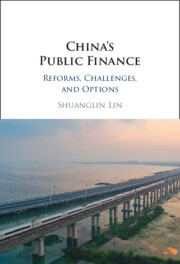Book contents
- China’s Public Finance
- Endorsement on Back Cover
- China’s Public Finance
- Copyright page
- Dedication
- Contents
- Figures
- Tables
- Preface
- About the Author
- 1 An Overview of China’s Public Finance
- 2 The Fall and Rise of Government Revenue
- 3 Value-Added Tax, Consumption Tax, and Other Taxes on Goods and Services
- 4 Individual Income Tax Reforms
- 5 Corporate Income Tax in China
- 6 The Size and Structure of Government Expenditure
- 7 Infrastructure Development and Financing
- 8 Social Security Reforms
- 9 Healthcare Reforms
- 10 China’s Growing Local Government Debt
- 11 Fiscal Relationship between the Central and Local Governments
- 12 Fiscal Reform for Equitable and Sustainable Growth
- References
- Name Index
- Subject Index
11 - Fiscal Relationship between the Central and Local Governments
Published online by Cambridge University Press: 22 September 2022
- China’s Public Finance
- Endorsement on Back Cover
- China’s Public Finance
- Copyright page
- Dedication
- Contents
- Figures
- Tables
- Preface
- About the Author
- 1 An Overview of China’s Public Finance
- 2 The Fall and Rise of Government Revenue
- 3 Value-Added Tax, Consumption Tax, and Other Taxes on Goods and Services
- 4 Individual Income Tax Reforms
- 5 Corporate Income Tax in China
- 6 The Size and Structure of Government Expenditure
- 7 Infrastructure Development and Financing
- 8 Social Security Reforms
- 9 Healthcare Reforms
- 10 China’s Growing Local Government Debt
- 11 Fiscal Relationship between the Central and Local Governments
- 12 Fiscal Reform for Equitable and Sustainable Growth
- References
- Name Index
- Subject Index
Summary
Chapter 11 analyzes the fiscal relationship between the central and local governments. It first examines China’s budget system and the central-local tax sharing system, the fiscal imbalance between local fiscal revenues and expenditures, and the massive fiscal transfers from the central to local governments. It then discusses fiscal decentralization through extra-budgetary revenue collection, land sales, and bank borrowing by local governments. Next, it discusses the fiscal imbalance of the central and local governments and regional fiscal disparities. Policy suggestions on how to improve the central and local fiscal relationship are provided in the end, including the increase in local government revenue and the shift of some expenditure responsibilities from local governments to the central government, as well as granting local governments more fiscal freedom.
- Type
- Chapter
- Information
- China's Public FinanceReforms, Challenges, and Options, pp. 350 - 390Publisher: Cambridge University PressPrint publication year: 2022

